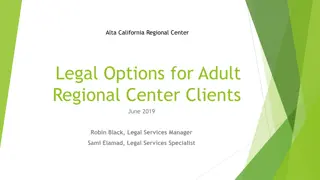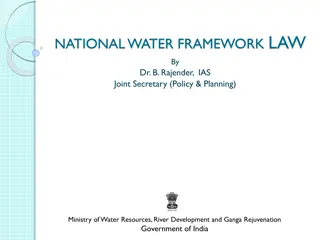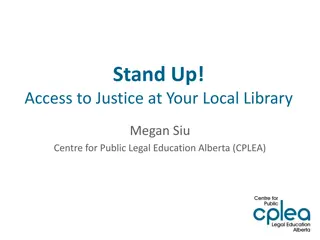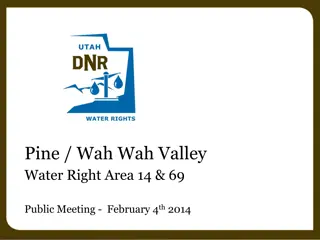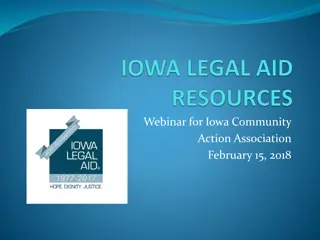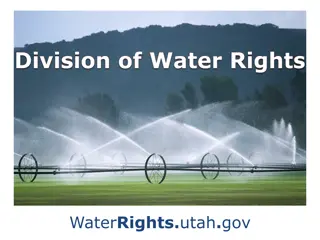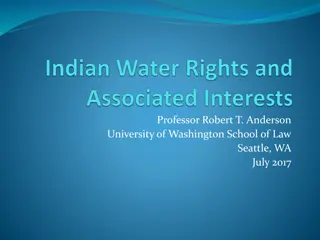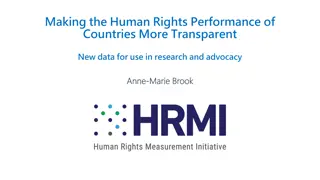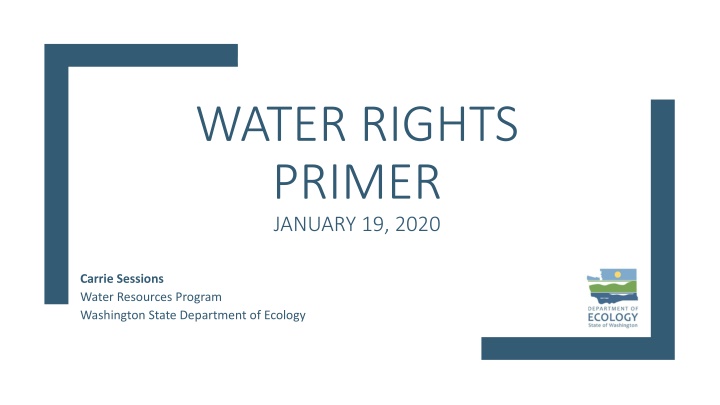
Water Rights in WA: Overview & Legal Framework
Water rights in Washington State are governed by laws dating back to the early 1900s, such as the 1917 Water Code and the 1945 Groundwater Code. This primer provides insights into establishing, maintaining, and changing water rights in the state, including the concept of prior appropriation. Learn about permit-exempt wells, relevant case law, and the requirements for beneficial use of water rights. Explore the processes for establishing a water right through claims, permit applications, or permit-exempt use, and understand the implications of abandonment and relinquishment. Discover how to maintain and change a water right in compliance with Washington State Department of Ecology regulations.
Download Presentation

Please find below an Image/Link to download the presentation.
The content on the website is provided AS IS for your information and personal use only. It may not be sold, licensed, or shared on other websites without obtaining consent from the author. If you encounter any issues during the download, it is possible that the publisher has removed the file from their server.
You are allowed to download the files provided on this website for personal or commercial use, subject to the condition that they are used lawfully. All files are the property of their respective owners.
The content on the website is provided AS IS for your information and personal use only. It may not be sold, licensed, or shared on other websites without obtaining consent from the author.
E N D
Presentation Transcript
WATER RIGHTS PRIMER JANUARY 19, 2020 Carrie Sessions Water Resources Program Washington State Department of Ecology
Overview Water law in WA 101 Relevant case law Postema, Swinomish, Foster, Hirst
Early Water Law Era of Appropriations 1917 Water Code (RCW 90.03) Established prior appropriation for surface water rights. 1945 Groundwater Code (RCW 90.44) Expanded prior appropriation to groundwater rights. Established permit-exempt groundwater withdrawals.
Establishing a water right Water rights can be established through: A claim ; A permit application submitted to the Dept. of Ecology; or A permit-exempt use. Prior Appropriation First in time, first in right . Seniority based on a priority date.
What is a water right? The right to use water: For a specific beneficial use. For a specific quantity. During a specified season. From a specific point of diversion or withdrawal. At a specific place.
Maintaining a water right Water rights are only valid to the extent that they are beneficially used. Abandonment: failure to use your water for a extended period of time and intention to give up the right. Relinquishment: failure to beneficially use your water for a period of 5 years or longer and failure to qualify for a sufficient cause of nonuse. See RCW 90.14.140.
Changing a water right To change a quality of a right, have to submit a change application to Ecology. Ecology must do an test of extent and validity of the right on all change applications. Examine whether the right has been relinquished via failure to beneficially use the right for a period of 5-years or more (or qualify for a sufficient cause for exemption/exception). Could result in a reduction of the right or finding that the entire right was relinquished.
Permit-exempt wells For certain groundwater uses, landowners may drill a well (and use the water) without first getting a water right permit from Ecology. Permit-exempt wells are still a water right and cannot impair senior users. Under RCW 90.44.050, permit-exempt uses include: A single home or groups of homes (up to 5,000 gpd); Livestock (no gallon per day limit); A non-commercial lawn or garden one-half acre in size or less (limited to reasonable use); and Industrial purposes, including irrigation (up to 5,000 gpd).
Instream Flow Protection 1969 Minimum Instream Flow Law (RCW 90.22) 1971 Water Resources Act (RCW 90.54) Source: Dave Nielsen, Flickr
Minimum Instream Flow Law (1969) The department of ecology may establish minimum water flows or levels for streams, lakes or other public waters for the purposes of protecting fish, game, birds or other wildlife resources, or recreational or aesthetic values of said public waters whenever it appears to be in the public interest to establish the same (RCW 90.22.010). Instream flow rules have a priority date of the rule s adoption. Ecology shall not grant rights that would conflict with instream flow rules.
Water Resources Act (1971) Uses of water for domestic, stock watering, industrial, commercial, agricultural, irrigation, hydroelectric power production, mining, fish and wildlife maintenance and enhancement, recreational, and thermal power production purposes, and preservation of environmental and aesthetic values, and all other uses compatible with the enjoyment of the public waters of the state, are declared to be beneficial (RCW 90.54.020(1)). The quality of the natural environment shall be protected and, where possible, enhanced as follows: (a) Perennial rivers and streams of the state shall be retained with base flows necessary to provide for preservation of wildlife, fish, scenic, aesthetic and other environmental values, and navigational values (RCW 90.54.020(3)).
WENATCHEE RIVER AT MONITOR, WA Flow Exceedence Probability Hydrograph with Two Years of Daily Flows USGS gage 12462500; Period of Record: 1963 - 2016 10% exceedance 50% exceedance 90% exceedance 1995 New ISF 100000 10000 Flow (cfs) log scale 1000 100 Oct Nov Dec Jan Feb Mar Apr May Jun Jul Aug Sep
Postema, et al. v. PCHB,et al. (2001) Appeal of a batch denial of applications to withdraw groundwater in hydraulic continuity with closed surface water sources. Rulings: Instream flow rights are rights subject to the same protection as any other water right. No impairment to existing rights are permissible, even de minimis impairment. Any effect on the flow or level of the surface water in closed streams would mean impairment.
Swinomish v. Ecology (2013) Appeal of Ecology s amendment to the Skagit Instream Flow Rule that created a reservation of water for domestic use. Ecology justified the reservation based off a finding of overriding consideration of the public interest (OCPI). Rulings: Ecology cannot use OCPI to justify water use that impairs existing instream flows. OCPI is a narrow exception and requires extraordinary circumstances before the minimum flow water right can be impaired.
Foster v. Ecology, et al. (2015) Appeal of a water right permit granted to a local city. Ecology had conditioned the permit on mitigation, including water for water and out-of-kind measures. We used OCPI to approve the application. Rulings: No impairment of instream flows are permissible, regardless of magnitude or ecological impact (reaffirming Postema). We cannot use out-of-kind mitigation, such as habitat improvements, to address impairment of instream flows. Legal vs. ecological impairment. Ecology cannot use OCPI to justify permanent allocations of water.
The perfect mitigation standard 1. In-place 2. In-time 3. In-kind water for water
Whatcom County v. Hirst, et al. (2016) Appeal of Whatcom County s Comprehensive Plan. Rulings: The plan failed to sufficiently protect water resources under the GMA. Counties have an independent responsibility to ensure that new permit-exempt uses do not impair senior uses, including instream flows. Counties cannot allow even de minimus impairment to instream flows.
Legislative Response: Streamflow Restoration (2018) In affected Hirst basins : People can build homes using a permit-exempt well; potential impacts to instream flows authorized. Includes a $500 fee and water use restrictions. Planning groups are convened to identify actions necessary to offset the consumptive impact from new permit-exempt wells. Plans must prioritize in-time and in-place mitigation. Plans must meet a net ecological benefit standard. Appropriated $300 million over 15 years for streamflow restoration projects statewide. Convened a Legislative task force to study the WA Supreme Court s Foster decision. Authorized 5 pilot projects.





